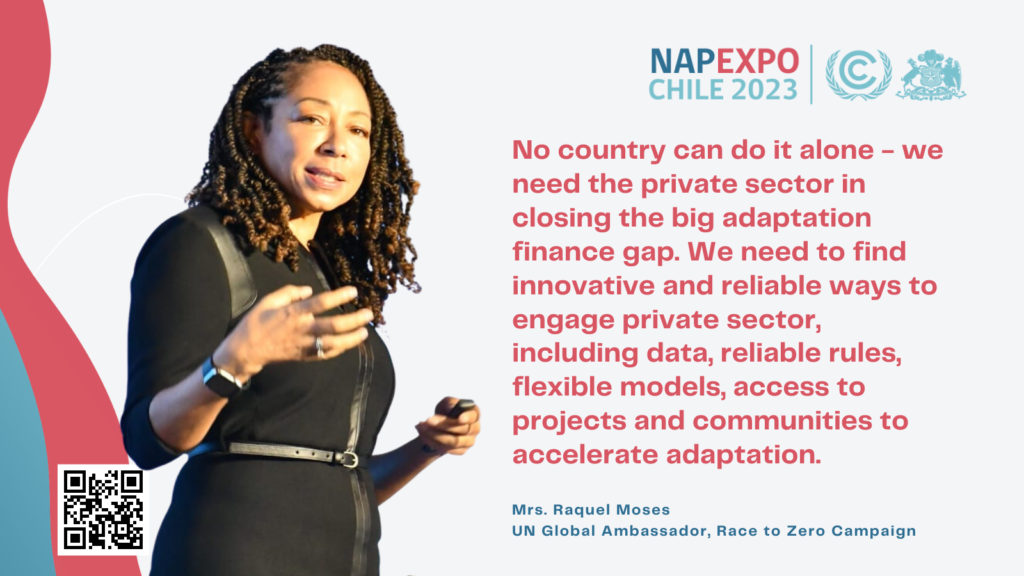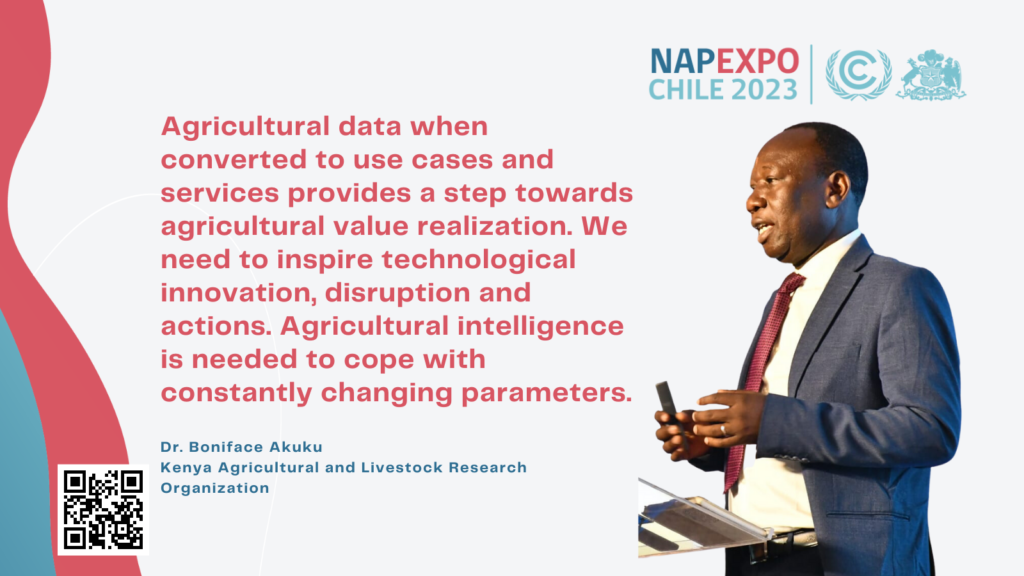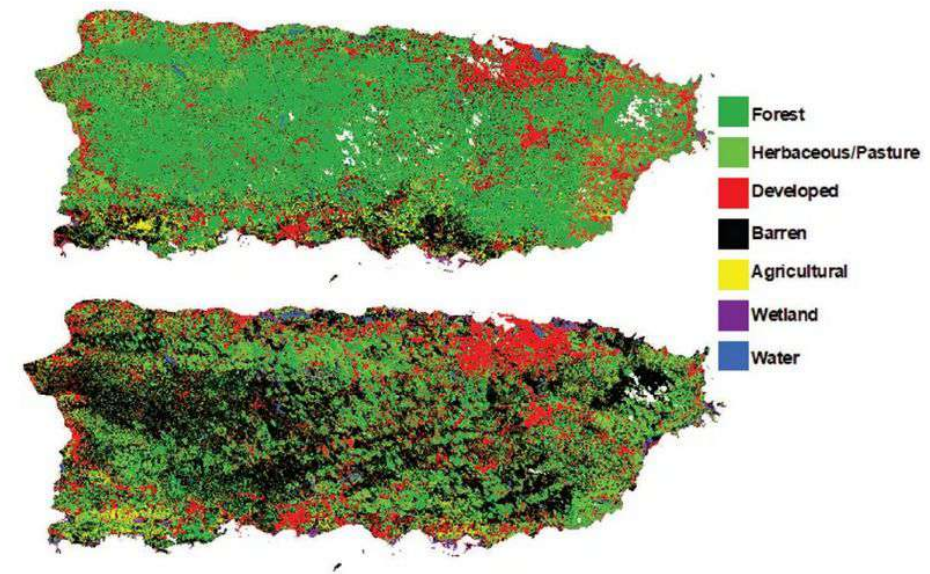

Innovation and collaboration with the private sector to scale up adaptation in the face of the huge gaps in adaptation funding set the scene for a packed day of sessions, as two keynote speakers described innovative approaches to adaptation and building resilience in the Caribbean and Africa.
Mrs. Racquel Moses, CEO of Caribbean Climate-Smart Accelerator and UNFCCC Race to Zero Global Ambassador, emphasized the critical need to involve the private sector right from the start, to craft policies and flexible models that allow for public-private sector collaboration— whether with multinationals or small entrepreneurs— as a way of narrowing the adaptation funding gap. She gave examples of such collaborations happening in the Caribbean countries, including a cement company building resilient infrastructure, another using plastic waste to strengthen concrete, one offering parametric insurance to cover disasters, and one that offers coral rehabilitation as a tourist activity. Another initiative she described was the Resilience Score Card, which allowed countries to rate their level of resilience based on their own priorities, from which the private sector could then decide what to support: for example, investing in a country based on how resilient they are or how vulnerable they feel.

Dr. Boniface Akuku, Director of ICT at Kenya Agricultural and Livestock Research Organization (KALRO), emphasized the need to disrupt the agricultural sector, and described the process of harnessing digital technology in Kenya to improve farming practices as part of a shift to a proactive response to climate change. This included analyzing data inputs from a wide variety of sources to provide microclimate data to farmers and extracting useable information from available agricultural research and making it accessible to farmers. Key lessons included that to succeed in harnessing digitization for climate adaptation requires investing in developing a digital strategy with a clear vision and target of the desired achievement, and the need for collaboration between private and public sectors and financial sustainability models. A key message was also to ensure turning data into service.

Transformative approaches in adapting food systems to climate change
Today’s keynotes followed the thread of food systems resilience that has featured strongly throughout the Expo. Two sessions covered this today, one showcasing good practices and lessons learned in climate change adaptation in Latin America and the Caribbean region associated with agriculture, water, biodiversity, forests, and soils, with the ultimate aim of unveiling transformative approaches in adapting food systems to climate change. It discussed and exchanged how national adaptation policies and instruments can support regional climate action through mechanisms such as the Climate Action Platform for Agriculture in Latin America and the Caribbean (PLACA).
The focus was broadened in another event that provided a space for key partners to share insights and guidance on how to support countries’ shift from NAP formulation to implementation in the agriculture and land-use sectors. It looked at practical tools to translate climate goals into actionable solutions and introduced a toolkit that aims to support national adaptation programmers in making this shift. The also highlighted SCALA country perspectives, challenges and lessons learned in assessing the transformative potential of adaptation priorities in agriculture and designing concrete implementation plans.
Monitoring, evaluation and learning to inform the design and implementation of adaptation actions
Monitoring, evaluation and learning in the context of global processes and reporting progress has risen in prominence against the backdrop of the first global stocktake and the ongoing discussions centered on developing a global goal on adaptation. Most countries are developing monitoring, evaluation, and learning (MEL) systems to track progress under the process to formulate and implement NAPs as there is a growing need for local communities affected by climate change, and for national governments leading the response, to see positive results from the NAPs and to know what is truly happening on the ground, adjust and create necessary measurements, in order to scale up adaptation actions.
In a peer-to-peer sharing session, NAP Exchange, Argentina and Haiti mentioned that they were elaborating their M&E strategies. Argentina’s will include metrics that will be flexible and dynamic to capture the specific characteristics of each region, while Haiti’s metrics will monitor aspects of the process of formulating and implementing the NAP as a whole and specific adaptation outcome across the priority sectors.
Modern computational environments and data products enable the assessment of biophysical and socioeconomic processes across the globe at high spatial and temporal resolution. The GEO secretariat announced the launch on 29 March 2023 of more than 60 cloud credits projects addressing climate action, disaster risk reduction and sustainable development in over 60 countries including LDCs and other developing countries. These projects are funded in collaboration with global technology providers such as Amazon Web Services, Google Earth Engine and Microsoft Planetary Computer, through dedicated programmes providing free licenses, grants, technical and financial support. The GEO4NAPS project, funded under the GEO-Microsoft Planetary Computer programme, aims to identify core sets of indicators for measuring adaptation progress with Earth observations from space, apply the measurement method to Malawi, and scale up the measurement method to other LDCs.
Figure 1 Change in land cover in Puerto Rican landscape following hurricane Maria

Scaling up adaptation through national adaptation programmes, long-term capacity and integration across different levels
Developing country need to address multiple issues to scale up adaptation and implement the Paris Agreement. LDCs, in particular, need tools and support to effectively and efficiently navigate the issues and requirements of the Paris Agreement and the Convention. One session highlighted the PA-ALIGN tool, which aims to provide countries with information on what they need to deliver, data requirements, opportunities for synergies and linkages between the different instruments and framework. The LEG, Adaptation Committee, Paris Committee on capacity-building and other UNFCCC provide additional support through different modalities. There is also rich experience from countries such as in Liberia in creating synergies in developing various national documents, in Fiji in monitoring and evaluation and in South Sudan in creating communities to address implementation challenges.
Effectively integrating adaptation across levels of governance requires a solid legal basis. Decentralization is key for empowering sub-national governments’ efforts on adaptation planning and implementation. An example on the Eswatini Environment Fund presented a positive example on the finance for sub-national actors to articulate their local priorities and implement them.
Fully and successfully engaging all actors and stakeholders to drive transformation
Putting stakeholders at the centre of planning and implementing adaptation is essential to a just, inclusive transition towards a climate resilient future and to driving the transformational action that will get us there. Putting people at the centre of climate action has been woven throughout the Expo so far.
A session on harnessing the power of youth in NAPs emphasized that young people are agents of change and can bring innovation and accelerate adaptation solutions. To leverage the power of youth, it is key to transform the narrative into one that recognizes youth as partners, not only as beneficiaries and victims of climate impacts. This would mean engaging youth in the design and implementation of NAPs and local adaptation plans, and seeing youth-led SMEs and initiatives at the local level as important partners to implement adaptation action.

That stakeholder engagement and ownership must be at the center of climate analytics to make an impact was reiterated— especially given that catalysing effective adaptation action relies on “a constellation of factors falling into place”, according to another session on breaking barriers to scaling up adaptation. Adaptation can be scaled up when understanding the different but complementary roles of multiple actors, businesses, financiers, cities, regions, civil service organizations.
The necessity of wide inclusion of stakeholders was reinforced by countries exchanging experiences. For example, Argentina engaged representatives of environmental organizations, unions, indigenous communities, universities, academic and business entities, and public and private research centers, and conducted an intercultural dialogue with indigenous people to identify risks, highlight the best practices from indigenous communities, propose adaptation measures, and highlight the role of indigenous women in the fight against climate change.
Scaling up technical assistance for NAP formulation and implementation
The NAP Expo featured the launch of two new supplements to the technical guidelines for the formulation and implementation of NAPs. The technical documents presented were the Nairobi Work Programme technical brief on “Promoting Synergies Between Climate Change Adaptation and Biodiversity” (in collaboration with the CBD Secretariat, IISD, NAP GN, GIZ, UNEP and SwedBio), and the GEO supplement on “Integrating Earth Observations into the Formulation and Implementation of National Adaptation Plans: Agriculture and Food Security”.

Moving from guidelines to the ground, UN4NAPs Forum had a busy day of discussions on technical assistance needs in two sessions, one on climate hazards and another on more general needs for technical assistance for NAP formulation and implementation. Participants and organizations explored the frequent and increasingly intense climate hazards, impacting the most vulnerable people, and women more severely, and leading to massive displacements of people as well as conflicts around land. The session noted that humanitarian concerns are becoming overwhelming and there is a shift of attention by international organizations from adaptation to humanitarian response. Needs for technical assistance included multi-risk assessments, monitoring and evaluation and information management systems including those to track climate finance, climate risk insurance solutions, strengthening institutional capacities, addressing the lack of human and financial resources, the definition of indicators and methodologies to prioritize adaptation options, and costing of adaptation measures. While different tools and guidance are available for countries to apply, many of the challenges that countries are facing are new and new and solutions have yet to be developed.
Kindly share the main outcomes of the expo…